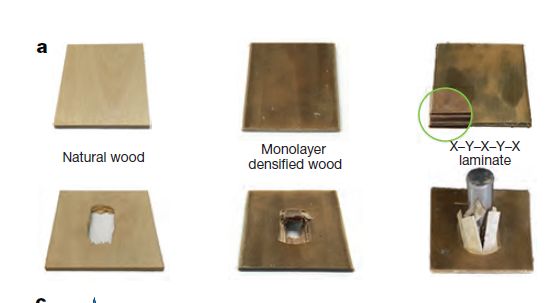Densified wood: In a very recent issue of Nature (Vol 554: 224-228), authors Jianwei Song and others reported that they were able to make wood into a very dense, very strong and tough material. They removed some of the lignin polymer and carefully crushed the remainder, mostly cellulose. The density increased from 0.42 grams per cubic centimeter to about three times that, denser than water. Basically, they collapsed the open conduits of wood, the xylem vessels that carry water and nutrients upward from the soil. They were able to layer it in alternating directions of the former grain, like plywood. Its strength (stress needed to break it) exceeds that of even high-strength steel . Interestingly, its toughness also increased (this is the energy or work needed to break it); ordinarily, toughness goes down as strength increases (e.g., see my post about spider silk). They had an interesting demo of toughness with a projectile shot into it.
It’s premature to say this will replace steel as a structural material in many applications. For one, densified wood swells alarmingly at high humidity, by 8.4% after 128 hours in 95% relative humidity. It’s not dimensionally stable then. One topic I didn’t see addressed is its anisotropy – its properties vary with the direction of applied stress. Even layered in alternating directions like plywood, in the third dimension, parallel to the original grains, I’d expect it to be easier to disrupt – to delaminate, as it were.
Densified wood also is not more resilient than steel. After hitting the highest stress that it can tolerate, it breaks down bit by bit at higher strains (relative extension).
Stay tuned.

